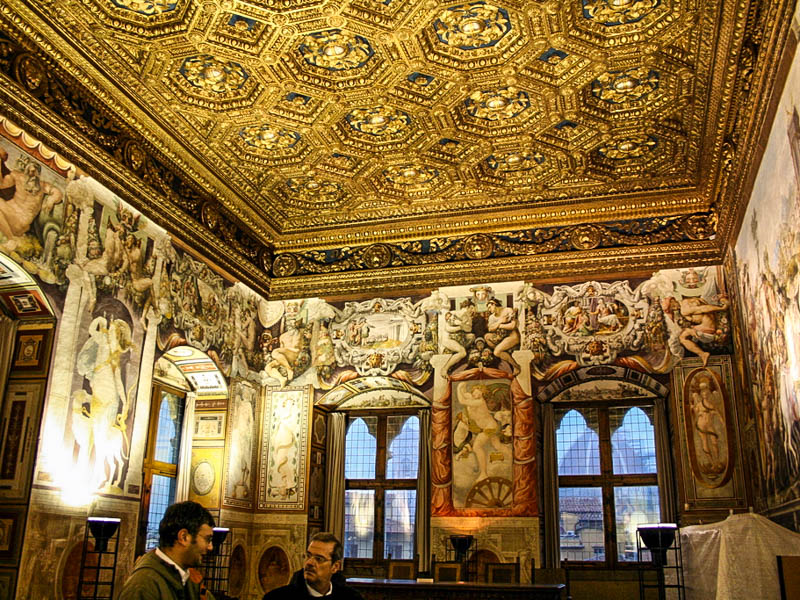
Florence's Palazzo Vecchio is a Gothic town hall decorated by Renaissance masters
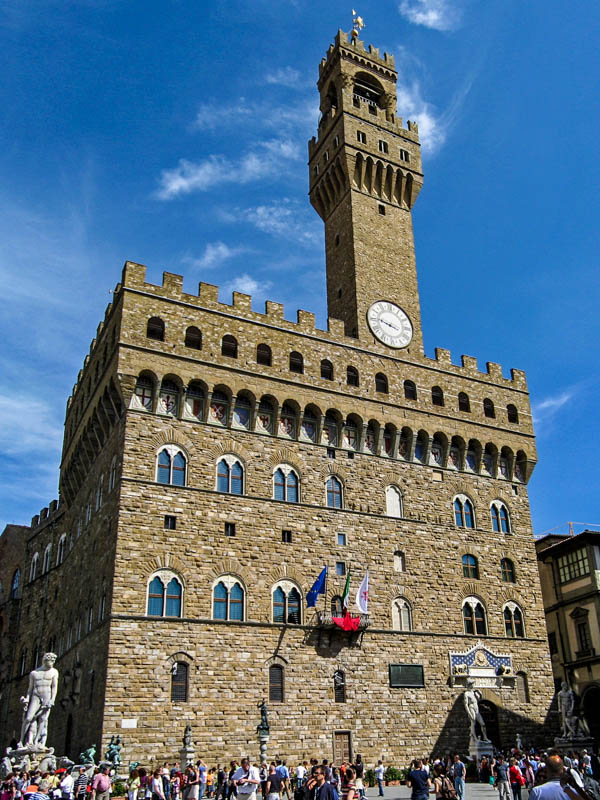
The late 13th-century Palazzo Vecchio (Old Palace) is a imposing rough-hewn fortress in severe Gothic style, replete with crenellations and battlements and highlighted by a 308-foot campanile that was a supreme feat of engineering in its day.
It served as Florence's city hall for many years (a role it fulfills again today) and then home to Duke Cosimo I de' Medici (that's Giambologna's bronze statue of him on horseback anchoring the middle of Piazza della Signoria outside).
Cosimo I lived here for 10 years beginning in 1540, when much of the interior was remodeled to the elegant Renaissance style you see today, before moving to new accommodations in the Palazzo Pitti.
You enter (maybe; see "Tips" below) off Piazza della Signora (past a replica of Michelangelo's The David on the site where the real one once stood) and through the stunning entry courtyard, with intricately carved columns and extraordinarily colorful 16th-century frescos by Vasari.
In the center of the courtyard is a fountain of a Putto Holding a Dolphin, a copy of Verrocchio's original (which is displayed upstairs).
Beyond this is a more workaday open courtyard crowded with staircases and portcullis doors and, most importantly, the ticket and information office, where you can buy admission to the rooms upstairs (and sign up for the often spectacular tours; see "Tips" below).
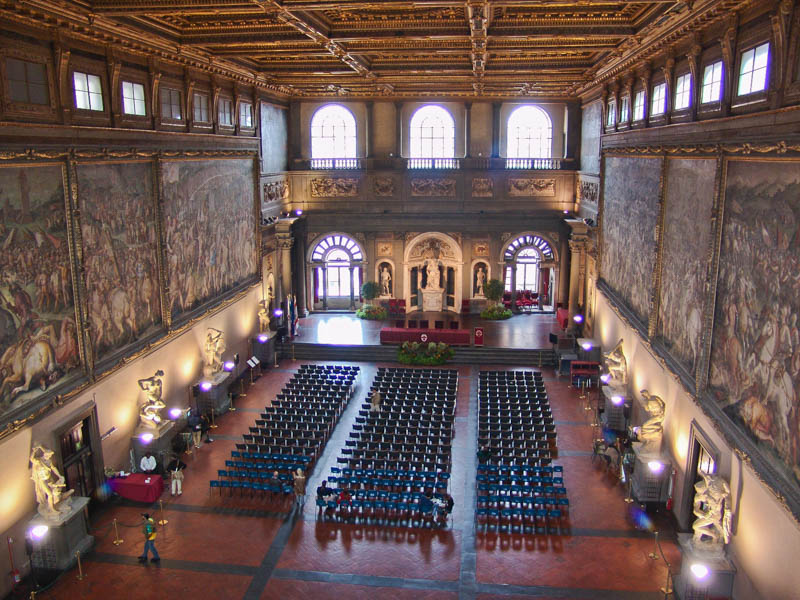
The highlight of the interior is the massive first-floor Salone dei Cinquecento (Hall of the Five Hundred), whose rich frescoes by Vasari depict Florence's history, with an emphasis on the greatness of his patron, Cosimo I.
Formerly the city's council chambers where the 500-man assembly once gathered, this grand hall is still used for government and civic functions.
There are several highlights in the huge room. The statue of The Genius of Victory is by Michelangelo (1533–34). Commissioned for the tomb of Pope Julius II, it was later acquired by the Medici from the artist's nephew and set up here. Its sinuous form (pictured below) inspired many of the Mannerist artists of the next generation.
Across the room from it stands Giambologna's plaster model for Virtue Overcoming Vice, commissioned to balance the Michelangelo.
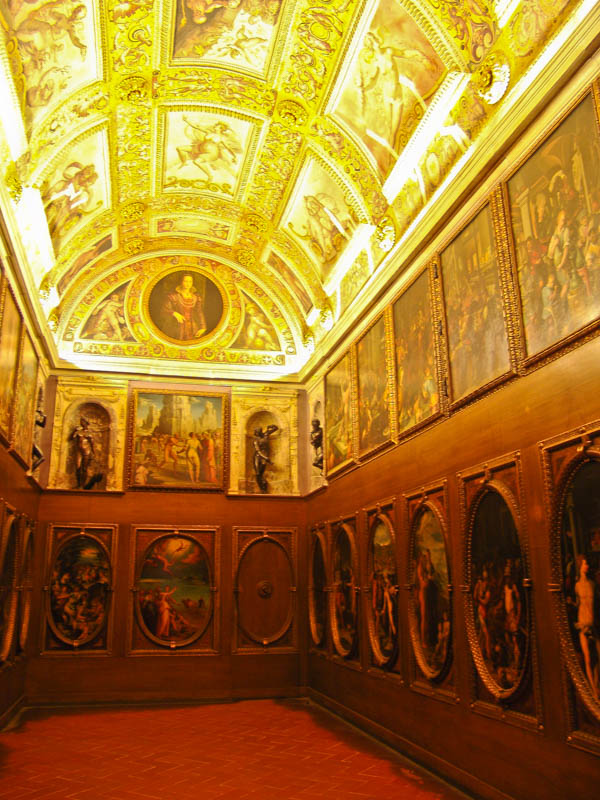
Off one corner opens the tiny, barrel-vaulted Studiolo of Francesco I, an elaborately decorated private office and laboratory where Francesco, Cosimo I's eldest son and successor as Grand Duke, could indulge in his scientific and alchemy experiments surrounded by paintings of allegory, myth, the natural elements, and his own family by the likes of Vasari and Il Poppi.
(The wall paintings conceal cabinets for the Duke's instruments and experimental materials—the panel in the back right conceals a door leading into the secret stairs and hidden halls within the palazzo walls, which you can see on the special tours described under "Tips" below.)
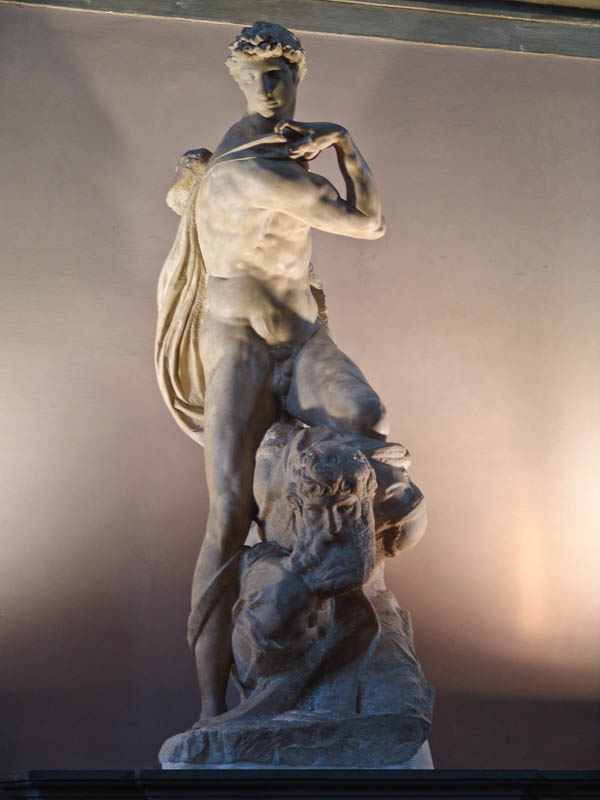
frescoes commissioned from the two greatest artistic Titans of Italian history. Leonardo da Vinci was to fresco one wall, and Michelangelo the other, with battle scenes showing Florence's past military victories.
Michelangelo completed the life-sized preparatory sketches called "cartoons" (because they were done on large paper, which in Italian is cartone) before being called to Rome by Pope Julius II (to "decorate" the ceiling of the Sistine Chapel).
His sketches were left in Florence, where they were studied and copied by many aspiring artists, most of whom decided to take home a piece here and there. Soon, nothing was left of these never-realized Michelangelo frescoes. All we know about them comes from a few copies made by artists I shall charitably call "less talented" than Michelangelo.
Da Vinci, on the other hand, got a good head start on his side of the room, but his frescoes were done in by the man's own eagerness to experiment. He mixed wax in with his pigments, but the resulting frescoes were not drying fast enough.
So, to speed up the drying, he had wood-fired braziers set up all along the base of the wall—then watched, in horror, as the heat melted the wax in the partly-finished frescoes and the images simply slid down off the wall to puddle on the floor.
Whether he started over again is unknown, since Leonardo left for Milan in 1506.
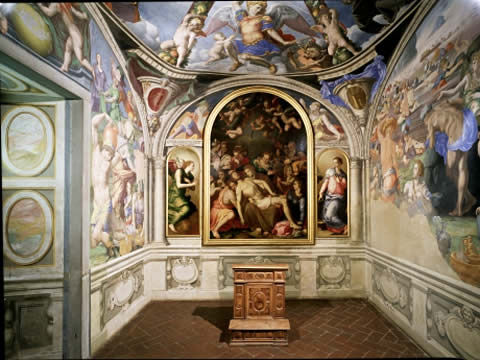
Upstairs on the secondo piano (third floor to Americans), the richly decorated and frescoed salons—including the private quarters of Cosimo's wife, Eleonora de Toledo—offer an intriguing glimpse into how the ruling class of Renaissance Florence once lived.
There are loads more works by Vasari, plus works by Ghirlandaio and Donatello and many lovely, intensely colors paintings by Bronzino, especially in the Cappella di Eleonora, a private chapel for the duchess.
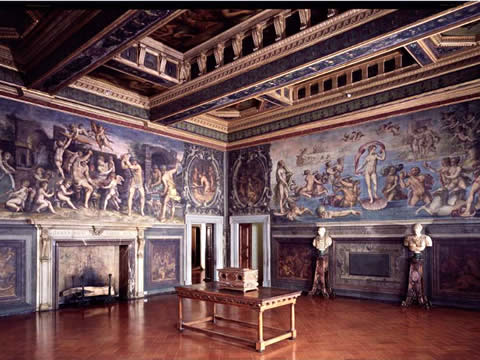
The Quartiere Elementi is an apartment suite envisoned in the mid 1550s by Cosimo I de' Medici and Giorgio Vasari as a Florentine equivalent to the Raphael Rooms of (Medici) Pope Leo X in the Vatican in Rome. It was the start of a long and fruitful relationship between the Grand Duke and the man who would become his chief artist and architect.
Each room is devoted to one of a variety of celestial beings—from the personified Elements (air, water, earth, fire) to the Titans (Saturno/Saturn, Opi/Ops—the Roman versions of Cronus and Rhea) and gods (Giove/Jupiter, Giunone/Juno) to demigods and muses (Ercole/Hercules, Calliope).
Here's the kicker: Directly below each room is a corresponding chamber of the same dimensions dedicated to an illustrious member of the Medici family—Cosimo il Vecchio below Ceres, Lorenzo Il Magnifico below Opi, Lorenzo's son Giovanni (Pope Leo X) below the Elements, etc.
Also up here are the elegant Sale dei Priori, the suite of public meeting rooms of the Florentine Republic.
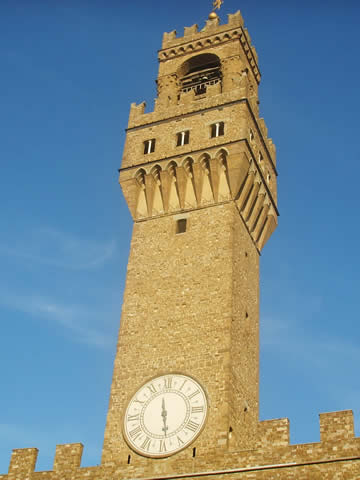
The 95-meter (312-foot) tall bell tower was most likely designed by Arnolfo di Cambio in 1299—hence its local nickname, Torre di Arnolfo—as part of the expansion of the palazzo.
The tower—with its iconic bulging top and two battlemented tiers of swallow-tailed merlons called merletti—was finished by 1322 and has been copied by buildings all around the world ever since.
The clock at the base of the tower is the 1667 handiwork of Bavarian clockmaker Georg Ledel—though the current clockface dates from a 19th century restoration.
The tower is topped by a weathervane featuring a rampant Marzocco lion and a lily, the twin symbols of Florence (replaced by a modern copy, the original is now in a courtyard of the palazzo).
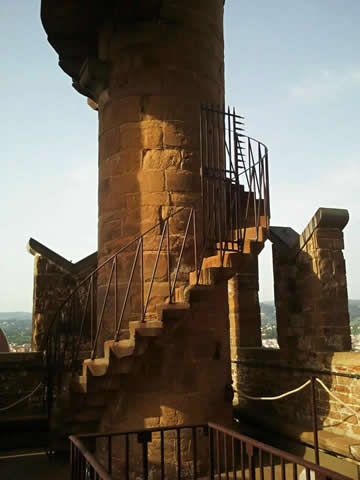
Long closed to the public, the Torre di Arnolfo re-opened in June, 2012 to anyone over the age of 6 who is willing to climb 223 steps to a magnificent (if vertiginous) panorama over the heart of Florence.
On the way up, you pass the Alberghetto ("little hotel"), a small chamber occasionally to house partciularly troublesome prisoners—from Cosimo Il Vecchio de' Medici (just before his brief exile) to Girolamo Savonarola (just before his being burned at the stake).
At the top are two bell chambers that house, among other bells, the famous Martinella, which once acompanied Florentine troops in battle on a cart to ring out military signals. For centuries, after it was installed in the Palazzo Vecchio tower, it was used to call the people of Florence to assemble on Piazza della Signoria. Silent throughout World War II, the bell was finally rung again on 11 August, 1944, as a signal to the partisans in town to rise up and help liberate Florence from the Nazis.
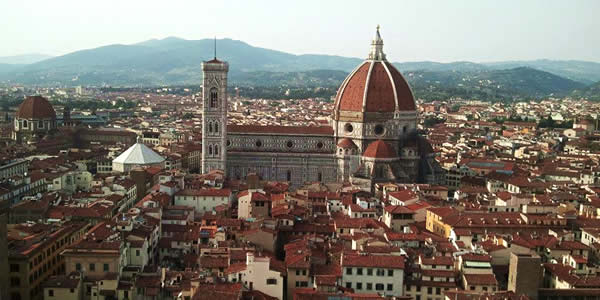
View from the Palazzo Vecchio tower.
Piazza della Signoria
tel. +39-055-276-8325
museicivicifiorentini.comune.fi.it
Apr-Sept: Fri–Wed 9am–mignight (9pm for tower), Thurs 9am–2pm
Oct-Mar: Fri–Wed 9am–7pm (5pm for tower), Thurs 9am–2pm
€10
With Firenze Card: Free
Bus: C1; C2; C3, D
Hop-on/hop-off: Santa Croce (A), Corso Tintori (C); Teatro Verdi (A)
Planning your day: he varied collections are just interesting enough to soak up an hour or two of your time. To take (or return for) a tour—which, rather than visiting the main rooms, takes you behind the scenes—will take another hour to 90 minutes (see below). The ticket office closes 1 hour before the museum.
The bookshop offers them for about €4 to give the frescoed chambers and great artworks some context.
The Palazzo Vecchio is covered by the Firenze Card—free admission, no waiting in line. » more
Take a guided tour of Palazzo Vecchio with one of our partners:
Share this page
Search ReidsItaly.com
Piazza della Signoria
tel. +39-055-276-8325
museicivicifiorentini.comune.fi.it
Apr-Sept: Fri–Wed 9am–mignight (9pm for tower), Thurs 9am–2pm
Oct-Mar: Fri–Wed 9am–7pm (5pm for tower), Thurs 9am–2pm
€10
With Firenze Card: Free
Bus: C1; C2; C3, D
Hop-on/hop-off: Santa Croce (A), Corso Tintori (C); Teatro Verdi (A)